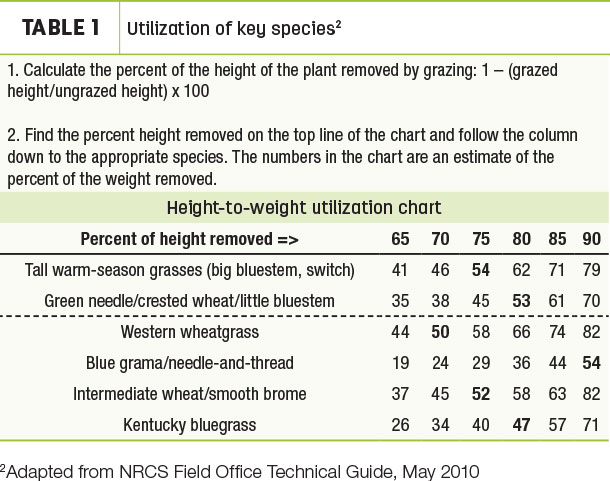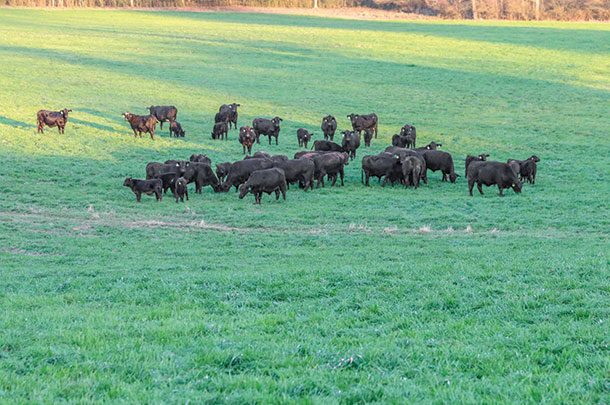Now is the time to evaluate your account and make sure it is balanced for the current grazing season. To accurately do this, it is important to understand the relationship between precipitation and forage production in your area. Within the Great Plains April-June precipitation is a good predictor of annual forage production in mixed-grass prairies. The best predictor in warm-season grass prairie is May-July precipitation.
Because of this relationship between precipitation and forage production, precipitation during these months can be used to predict potential deficits in forage production. This enables ranchers to make decisions earlier in the grazing season, balance their forage needs and supply, and reduce risk.
We are well into the growing season and, as it progresses, the potential for timely precipitation and forage growth decreases. By July 1, cool-season-dominated grasslands have produced 90 percent of their forage, whereas this is delayed to Sept. 1 for warm-season-dominated grasslands. There are a few methods to aid ranchers in predicting the potential for forage production.
1. Compare the current year’s precipitation during this time period to the 30-year average for your location. You can use this information to calculate the probability of receiving adequate precipitation for forage growth.
2. Evaluate weather prediction models from the National Oceanic Atmospheric Administration’s Climate Prediction Center of precipitation and temperatures for the remainder of the growing season.
3. Reference Grass-Cast, a forage production prediction tool developed by the USDA Agricultural Research Service, Colorado State University, National Drought Mitigation Center, University of Arizona and the USDA Northern Plains Climate Hub. This tool compares seasonal estimate to a 34-year average to develop county-level forage production maps for three precipitation scenarios, above-normal, near-normal and below-normal, which are updated every two weeks.
The ability to better predict annual forage production allows ranchers to adjust their forage withdraws accordingly to ensure stocking rate is not exceeding carrying capacity. The stocking rate is the number of specific kinds and classes of animals grazing or using a unit of land for a specific time period. When setting the stocking rate, knowing the carrying capacity of the pasture is critical. Carrying capacity is a measure of how much forage a grazing unit has and is able to produce in an average year.
However, these are just estimates, and there are several other factors that influence carrying capacity, including growing conditions last year, grazing history and, of course, stocking rate. The most accurate way to determine carrying capacity or forage available for grazing is the clip and weigh method. To use this method, producers would clip five to 15 frames (1.92 feet squared) of forage, dry the bags and then weigh using a gram scale. Average the weights and multiply by 50 to calculate the pounds per acre. Next, they should multiply by the acres in the pasture to determine the quantity of forage.
However, this is not the available forage, as we need to account for trampling and waste (about 25 percent) while ensuring we are leaving sufficient plant material to maintain healthy vegetation (about 50 percent). This leaves us with 25 percent of the forage for livestock consumption. We would then divide this number by the amount of forage required for livestock to get the carrying capacity. For example, a 1,000-pound cow with a calf consumes 913 pounds of forage per month. The NDSU Grazing Calculator App can help with these calculations.
Producers also can use a visual assessment method to estimate utilization, although this method is subject to user bias. The recommended utilization level for forage is 40 to 60 percent. At this level, rangeland utilization is fairly uniform, with 65 to 80 percent of the height of desirable forage species being grazed. Livestock should be removed when this level is exceeded. When you exceed this level, desirable forage species will be cropped closely, removing more than 80 percent of the plant height and livestock consuming low-quality species.
If producers have grazing exclosures, or an ungrazed area adjacent to the grazing unit with similar forage species, they can use a grazing monitoring stick to determine utilization. Here are the steps for using the grazing monitoring stick:
1. Calculate the percent of the plant height removed by dividing the grazed height of the plant by the ungrazed height. Subtract this amount from 1.
2. Multiply this amount by 100 to determine the percent of height removed.
3. Correlate this number with those in Table 1 to estimate the percent of entire plant weight removed.

A general rule of thumb is to target 50 percent utilization by weight during a grazing period as well as at the end of the grazing season. If greater than 50 percent utilization occurs during a grazing period, plant recovery will be slower, which means plants require a longer recovery period between grazing events to maintain their health.
Predicting potential forage production and monitoring available forage to ensure your livestock are not overdrawing from your account is critical for the environmental and economic sustainability of your ranch. This is especially evident in drought years when early decision-making can reduce the potential for costly drought-related consequences. ![]()
PHOTO: The key is ensuring stocking rate does not exceed carrying capacity. Photo by David Cooper.

-
Miranda Meehan
- Livestock Environmental Stewardship Specialist
- North Dakota State University
- Email Miranda Meehan









